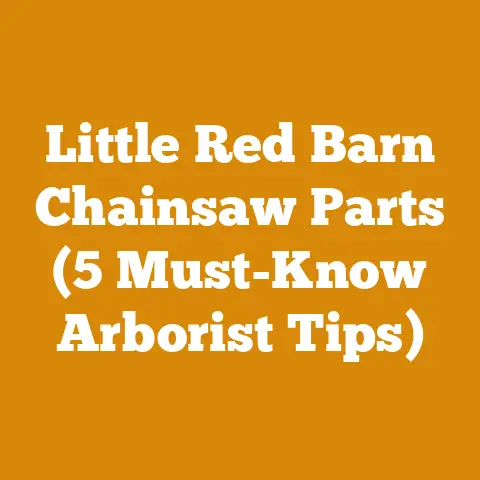Burning Rotten Firewood (5 Expert Tips for Safe Heating)
Okay, let’s tackle the challenging topic of burning rotten firewood. It’s a question I’ve been asked countless times over my years in the wood processing and firewood business. The short answer is, generally, no, you shouldn’t burn rotten firewood. But the long answer is more nuanced, and that’s what we’re going to explore. I’ll share my experiences, the science behind it, and give you practical tips to ensure your wood-burning endeavors are safe and efficient. We’ll dive deep into identifying rot, understanding its impact on heat output and safety, and exploring alternative uses for wood that’s past its prime.
Understanding the Risks and Realities
Before we delve into the “how,” let’s address the “why not.” Burning rotten firewood presents several challenges:
- Reduced Heat Output: Rot is essentially wood decay caused by fungi. These fungi consume the cellulose and lignin, the very components that provide the fuel for fire. This means rotten wood has significantly less energy content than sound wood. You’ll need to burn much more of it to achieve the same level of heat.
- Increased Smoke Production: Rotten wood is often wetter than seasoned wood, even if it appears dry on the surface. This excess moisture leads to incomplete combustion, resulting in more smoke. Smoke contains harmful pollutants and creosote, which can build up in your chimney and increase the risk of a chimney fire.
- Safety Hazards: Rotten wood can be structurally unsound. When burning, it might crumble or collapse unexpectedly, potentially causing a fire hazard. Furthermore, some types of rot can release spores or other harmful substances when burned, posing a health risk.
- Appliance Damage: Burning excessively smoky wood can damage your wood stove or fireplace. Creosote buildup can corrode metal components and reduce the efficiency of your appliance.
I once made the mistake of trying to burn a pile of partially rotten oak that I thought was “good enough.” The result? A smoky, sputtering fire that barely warmed the room and left a thick layer of creosote in my chimney. It was a valuable lesson learned.
Tip 1: Identifying Rotten Firewood – Know Your Enemy
The first step in avoiding the pitfalls of burning rotten firewood is learning to identify it. Here’s what to look for:
- Visual Signs:
- Discoloration: Look for unusual colors like white, yellow, brown, or black streaks or patches within the wood. These indicate fungal activity.
- Softness: Healthy wood is hard and dense. Rotten wood will feel soft, spongy, or crumbly to the touch. You should be able to easily dig into it with a knife or screwdriver.
- Fungal Growth: Obvious signs like mushrooms, shelf fungi (bracket fungi), or mold growing on the wood are clear indicators of rot.
- Cracks and Voids: Rotten wood often develops deep cracks and voids as the internal structure breaks down.
- Smell: Rotten wood often has a musty, earthy, or moldy odor. This is a telltale sign of fungal decay.
- Weight: Rotten wood is often lighter than sound wood due to the loss of density caused by fungal decomposition.
Types of Rot:
Understanding the different types of rot can help you assess the severity of the damage:
- Brown Rot: This type of rot primarily attacks the cellulose in the wood, leaving behind a brown, crumbly residue. Brown rot significantly reduces the structural integrity of the wood.
- White Rot: This type of rot attacks both the cellulose and lignin in the wood, resulting in a bleached or whitish appearance. White rot can make the wood spongy or stringy.
- Soft Rot: This type of rot is caused by fungi that can tolerate very wet conditions. Soft rot often occurs in wood that is in contact with the ground or constantly exposed to moisture.
I remember one time I was offered a “free” load of firewood. It turned out to be mostly birch that had been sitting on the ground for several years. It looked okay from a distance, but up close, it was riddled with white rot. I politely declined the offer, knowing the headache it would cause.
Tip 2: Assessing the Severity of the Rot
Not all rot is created equal. The severity of the rot will determine whether the wood is completely unusable or if it can be salvaged for certain purposes.
- Surface Rot: If the rot is only present on the surface of the wood and doesn’t penetrate deeply, you might be able to salvage the core of the log. You can remove the rotten outer layer with an axe or chainsaw. However, be sure to inspect the remaining wood carefully for any signs of internal decay.
- Localized Rot: If the rot is confined to a small area of the log, you might be able to cut out the affected section and use the remaining sound wood.
- Extensive Rot: If the rot is widespread throughout the log, the wood is generally not suitable for burning. It’s best to find alternative uses for it (see Tip 5).
Quantifying Rot:
While there’s no precise scientific measure for “rot severity,” here’s a practical scale I use based on my experience:
- Level 1 (Slight): Surface discoloration, minimal softening. Can be salvaged with minimal effort. Moisture content likely elevated.
- Level 2 (Moderate): Noticeable softening, some cracking, localized fungal growth. Requires significant effort to salvage, potential smoke issues. Moisture content significantly elevated.
- Level 3 (Severe): Extensive decay, crumbling texture, widespread fungal growth, significant weight loss. Unsafe to burn, use for other purposes. Very high moisture content.
Tools for Assessment:
- Moisture Meter: A moisture meter is an invaluable tool for assessing the moisture content of firewood. Healthy, seasoned firewood should have a moisture content of 20% or less. Rotten wood will often have a moisture content of 30% or higher. I use a Delmhorst BD-2100, which is reliable and accurate.
- Probe: A simple probe, like a screwdriver or awl, can be used to test the hardness of the wood. If the probe penetrates easily, the wood is likely rotten.
- Axe or Hatchet: Chopping into the wood with an axe or hatchet can reveal the extent of internal decay.
Tip 3: Safe Burning Practices – If You Must Burn Rotten Wood
I strongly advise against burning rotten firewood. However, if you find yourself in a situation where it’s your only option (e.g., emergency situation, limited resources), here are some safety precautions to take:
- Burn it Outdoors: Never burn rotten wood in an enclosed space like a wood stove or fireplace. Burn it in an open-air fire pit or bonfire, away from any structures or flammable materials.
- Burn it Sparingly: Don’t rely on rotten wood as your primary fuel source. Use it sparingly, mixed with sound wood, to minimize smoke production and safety risks.
- Maintain a Hot Fire: A hot fire will help to burn off some of the excess moisture and reduce smoke. Make sure you have plenty of kindling and tinder to get the fire going quickly.
- Supervise the Fire Closely: Never leave a fire burning rotten wood unattended. The wood may crumble or collapse unexpectedly, posing a fire hazard.
- Wear Protective Gear: Wear gloves, eye protection, and a dust mask to protect yourself from spores and other harmful substances that may be released when burning rotten wood.
- Clean Your Chimney Regularly: If you burn rotten wood in a wood stove or fireplace, even occasionally, be sure to clean your chimney more frequently to remove creosote buildup. I recommend having your chimney professionally inspected and cleaned at least once a year.
Case Study: Emergency Burning Scenario
I once found myself in a situation where I had to rely on some questionable firewood. I was on a camping trip in a remote area, and the only wood available was a pile of partially rotten aspen that had been left behind by previous campers. I knew it wasn’t ideal, but I needed a fire for cooking and warmth.
I followed the safety precautions outlined above. I burned the aspen outdoors in a well-ventilated fire pit, mixed it with some dry twigs and branches I found nearby, and maintained a hot fire. I also kept a close eye on the fire and made sure it was completely extinguished before leaving the campsite. It wasn’t the most enjoyable fire, but it served its purpose.
Tip 4: Seasoning and Storage – Preventing Rot in the First Place
The best way to avoid burning rotten firewood is to prevent it from rotting in the first place. Proper seasoning and storage are crucial for preserving the quality of your firewood.
- Seasoning: Seasoning is the process of drying out green wood to reduce its moisture content. This makes the wood easier to burn, reduces smoke production, and increases heat output.
- Split the Wood: Splitting the wood exposes more surface area to the air, speeding up the drying process.
- Stack the Wood: Stack the wood in a single row, off the ground, with good air circulation. Use pallets or scrap wood to create a base for your woodpile.
- Cover the Wood: Cover the top of the woodpile with a tarp or sheet of metal to protect it from rain and snow. Leave the sides of the woodpile open to allow for air circulation.
- Allow Adequate Drying Time: The amount of time it takes to season firewood depends on the type of wood and the climate. Generally, hardwood like oak and maple requires at least 6-12 months of seasoning, while softwood like pine and fir may only require 3-6 months.
- Storage: Once the wood is seasoned, store it in a dry, well-ventilated location.
- Elevated Storage: Store the wood off the ground to prevent moisture from wicking up into the wood.
- Covered Storage: Store the wood under a roof or tarp to protect it from rain and snow.
- Ventilated Storage: Ensure good air circulation around the woodpile to prevent moisture buildup.
Data on Drying Times:
Based on my experience and research, here’s a table outlining typical drying times for different types of wood:
| Wood Type | Initial Moisture Content (%) | Target Moisture Content (%) | Drying Time (Months) |
|---|---|---|---|
| Oak | 60-80 | 20 or less | 12-24 |
| Maple | 50-70 | 20 or less | 9-18 |
| Birch | 40-60 | 20 or less | 6-12 |
| Pine | 30-50 | 20 or less | 3-6 |
These are estimates, and actual drying times may vary depending on the climate, storage conditions, and wood size. Regular moisture meter checks are essential.
Tip 5: Alternative Uses for Rotten Wood – Don’t Let it Go to Waste
Even if rotten wood isn’t suitable for burning, it doesn’t have to go to waste. Here are some alternative uses for rotten wood:
- Composting: Rotten wood can be added to your compost pile. It will break down slowly and provide valuable nutrients to your soil.
- Mulch: Rotten wood can be used as mulch around trees and shrubs. It will help to retain moisture in the soil and suppress weeds.
- Soil Amendment: Rotten wood can be tilled into the soil to improve its structure and drainage.
- Mushroom Cultivation: Some types of mushrooms thrive on rotten wood. You can use rotten wood to create a mushroom bed in your garden.
- Wildlife Habitat: Rotten logs and stumps provide valuable habitat for insects, amphibians, and other wildlife. You can leave rotten wood in your yard to create a natural habitat for these creatures.
- Biochar Production: While more advanced, you can use a kiln to convert the rotten wood into biochar. It increases water retention and can add nutrients to the soil.
My Experience with Composting Rotten Wood:
I’ve had great success composting rotten wood in my garden. I simply add the rotten wood to my compost pile along with other organic materials like leaves, grass clippings, and food scraps. The rotten wood breaks down slowly, adding valuable nutrients and improving the structure of the compost. I’ve found that compost made with rotten wood is particularly beneficial for growing vegetables and flowers.
Strategic Advantages of Proper Firewood Management:
Beyond the immediate benefits of safe and efficient burning, proper firewood management offers strategic advantages:
- Cost Savings: Seasoned wood burns more efficiently, reducing the amount of wood you need to purchase or harvest.
- Environmental Responsibility: Burning seasoned wood reduces smoke production, minimizing your impact on air quality.
- Appliance Longevity: Burning seasoned wood reduces creosote buildup, extending the life of your wood stove or fireplace.
- Self-Sufficiency: Managing your own firewood supply provides a sense of self-sufficiency and independence.
Next Steps:
- Inspect Your Firewood Supply: Take a close look at your current firewood supply and identify any pieces that show signs of rot.
- Assess the Severity of the Rot: Determine the extent of the rot and decide whether the wood is safe to burn or if it should be used for alternative purposes.
- Implement Proper Seasoning and Storage Practices: If you plan to harvest your own firewood, be sure to follow proper seasoning and storage practices to prevent rot.
- Consider Alternative Fuel Sources: Explore alternative fuel sources like wood pellets or propane if you want to avoid the challenges of burning firewood altogether.
- Consult with a Professional: If you have any questions or concerns about burning firewood, consult with a qualified chimney sweep or wood stove installer.
Burning rotten firewood is generally not recommended due to reduced heat output, increased smoke production, and safety hazards. However, if you must burn it, follow the safety precautions outlined in this guide. The best way to avoid burning rotten firewood is to prevent it from rotting in the first place through proper seasoning and storage. And remember, even rotten wood can be put to good use in your garden or landscape.






